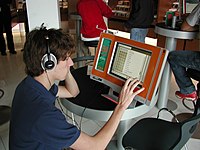
Photo from wikipedia
The goal of this research was to provide a new approach for analyzing orthodontic teeth arrangement inside oral depending on the rotation matrix computation and resistance detection. The present method… Click to show full abstract
The goal of this research was to provide a new approach for analyzing orthodontic teeth arrangement inside oral depending on the rotation matrix computation and resistance detection. The present method includes the following operations within a certain therapy period: first three-dimensional positions of the tooth were evaluated with a pierced laser beam and a three-dimensional system of surface-scanning. Second, the three-dimensional shape data was automatically registered at maxillary 1st molars, and methods of coordinate had been normalized. Third, a translation vector and rotation matrix had been evaluated from automatic registration of two position data of a particular tooth. Fourth, the limited spiral axes of teeth had been measured as the zero rotational dislocation locus; and impressions for a model of the dental cast had been taken at five different points: shortly before and after device was fitted, and ten days, one month, and two months after the treatment started. The results showed that existing analysis approach could more quickly classify a specific tooth's movement by spinning all over and translating along a finite helical axis. It can provide statistical visual three-dimensional data on complex tooth arrangement throughout orthodontic therapy.
Journal Title: Computational Intelligence and Neuroscience
Year Published: 2022
Link to full text (if available)
Share on Social Media: Sign Up to like & get
recommendations!